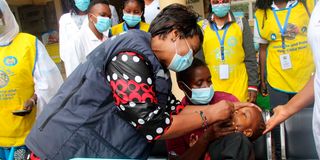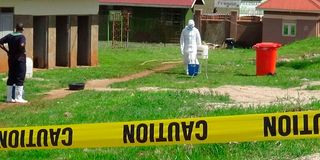Top five deadly diseases to watch out for in Africa ahead of 2025

World Health Organization Kenya Disease Prevention and Control Officer Joyce Onsongo administers a polio vaccine to a child in Kibera, Nairobi, after a polio outbreak in Garissa County and a possible risk was identified in Nairobi.
What you need to know:
- The diseases include Ebola, Polio, Chikungunya,Zika Virus and Mpox.
- Reserachers disclose that based on their observations it will take more than 50 years before the continent has access to a full suite of products for all priority pathogens due to funding constraints.
As 2024 nears its end, scientists have mapped out the five deadliest diseases with a ‘pandemic potential’ in Africa that they believe governments need to be on the lookout for in 2025.
The diseases include Polio, Ebola, Chikungunya, Zika and Mpox. The scientists disclose that based on their observations, it will take more than 50 years before the continent has access to a full suite of vaccines and medicine for all priority pathogens due to funding constraints.
But where did the deadliest pathogens come from?
According to the Impact Global Health 2024 EID report, which analyses global investment into research and development for emerging infectious diseases(EID), the researchers classify the deadly pathogens into six categories to explain their origin - multi- filovirus, multi-arenaviral, multiple or other non-Nipah henipaviruses, multiple bunyaviruses and ‘Disease X’.
Multi-filovirus
This is the family of viruses that includes Ebola and Marburg.
The most menacing member of the Filovirus family is Ebola - or more specifically the Zaire Ebolavirus that caused a devastating two year-long epidemic in West Africa beginning in 2014.
Besides Zaire Ebolavirus, the Ebolavirus subgroup of the Filoviruses includes three more prime suspects: Sudan Ebolavirus - a close cousin of Zaire, Taï Forest Ebolavirus and Bundibugyo Ebolavirus. Disease detectives are also wary of two other members of the Ebolavirus sub-group which have not yet been known to cause disease in people.
Researchers highlight that within the Marburgvirus sub-group of the Filoviruses, Marburg Virus and Ravn Virus are the key culprits.
Multi-arenaviral
Multi-arenaviral are five pathogens that recently emerged from rodents and this means that humans are only but their ‘accidental hosts’.
Four cause severe hemorrhagic fever with a mortality of about 15 per cent among hospitalised patients in circumscribed areas (Lassa virus in West Africa, Junin virus in the Argentine pampas, Machupo virus in Bolivia, and Guanarito virus in Venezuela).
The fifth, lymphocytic choriomeningitis virus, is much more widely distributed, but causes milder infections, often neurologic according to researchers.
Non-Nipah henipaviruses
Hendra virus and Nipah virus are highly pathogenic viruses that have recently emerged from flying foxes (also called fruit flies), disease detectives say.
The disease can also spread through pigs and other animals like goats, horses, dogs or cats meaning that they jump from animals to human beings.
Multiple bunyaviruses
Experts say that they cause fevers sometimes with rash. In addition, Crimean-Congo hemorrhagic fever virus may cause hemorrhage; Rift Valley fever virus may cause hemorrhagic hepatitis, encephalitis, or blindness; La Crosse virus and related viruses may cause encephalitis; and Hantaan virus and related viruses may cause hemorrhage and renal failure or the hantavirus pulmonary syndrome.
‘Disease X’
‘Disease X’ pathogens are yet to be known although they have pandemic potential.
Why Africa must watch out for these five diseases
1. Polio
Did you know that humans are the only reservoir for the polio virus?
Poliomyelitis, also known as polio or infantile paralysis, is a vaccine-preventable systemic viral infection affecting the motor neurons of the central nervous system (CNS).
There are three distinct serotypes of wild polio virus (WPV), types 1, 2 and 3, and infection or immunisation with one serotype does not induce immunity against the other two serotypes.
Transmission of both WPV2 and WPV3 have been successfully interrupted globally and cases were last reported in 1999 and 2012, respectively.
Oral polio vaccine (OPV) is produced from live attenuated WPV. On very rare occasions, if a population is seriously under-immunised, the virus can transform into pathogenic strains, known as vaccine derived poliomyelitis virus, and circulate in the community. These viruses are called circulating vaccine-derived polioviruses (cVDPV).
Historically, it has been a major cause of mortality, acute paralysis and lifelong disabilities, but large scale immunisation programmes have eliminated polio from most areas of the world.
However, the disease is now confined to a few endemic areas.
“Cases due to wild poliovirus have decreased by over 99 per cent since 1988, from an estimated 350 000 cases then, to 22 reported cases in 2017. As a result of the global effort to eradicate the disease, more than 16 million people have been saved from paralysis,” notes Africa CDC.
It notes that polio cases have been recorded in Kenya, Somaila, DRC where 85 people died as a result of the disease in 2010, Nigeria, Madagascar, Cameroon, Equitorial Guinea,South Sudan, Ethiopia and Angola.
On 5 May 2014, the World Health Organization declared the international spread of wild poliovirus in 2014 a Public Health Emergency of International Concern.
In October this year, the Ministry of Health in Kenya launched a nationwide polio vaccination campaign in response to a recent outbreak of circulating Vaccine-Derived Poliovirus Type 2 in the country. This is according to State Department for Public Health and Professional Standards PS Mary Muthoni.
The nationwide campaign came after five cases were confirmed, including four children from Kakuma Refugee Camp in Turkana County and one positive environmental surveillance sample in Kamukunji, Nairobi.
The vaccination campaign targeted over 3.8 million children under the age of five across nine high-risk counties: Nairobi, Busia, Bungoma, Turkana, Trans Nzoia, West Pokot, Kiambu, Machakos, and Kajiado.
A week later, county governments rallied behind the Health ministry to reach 3,119,158 children under five years across the counties.
“This campaign marks the second of the three planned vaccination rounds following the confirmation of a polio outbreak in Garissa County in June this year. The five-day vaccination drive focuses on 10 high-risk counties: Mandera, Wajir, Tana River, Lamu, Kitui, Machakos, Kiambu, Kajiado, Nairobi, and Garissa,” Dr Rose Jalango, head of the National Vaccine and Immunization Program, told Healthy Nation while urging all vaccinators to go the extra mile and reach every household to ensure that all children under five have received the jab.
Considering that Kenya is plagued by a lot of vaccine misinformation and disinformation, especially on social media, on behalf of WHO Country Representative, Dr David Rotich reminded that vaccines save lives and reiterated the critical need to vaccinate all children under five in high-risk counties like Nairobi.
While encouraging parents to ensure their children receive all other required vaccinations, he also stressed the importance of ensuring that children receive all eligible routine vaccines, as missing immunisations can pose significant risks to public health.
2. Mpox
On October 11 this year, the Africa CDC reported that there have been 38,300 Mpox cases (7,339 confirmed cases) and 979 deaths so far in Africa.
The disease was first detected in laboratory monkeys in 1958. It is believed to be transmitted from wild animals such as rodents to humans or through human-to-human contact and is a rare viral disease typically spread through body fluids and respiratory droplets.

Mpox is now a public health emergency in Africa
As it stands now, the DRC accounts for the vast majority of the reported cases and deaths on the continent, with the virus circulating predominantly in West Africa.
This means that DRC, Burundi, Nigeria, Cote d’Ivoire, and Uganda represent the top five countries reporting the highest confirmed cases, accounting for 98.7 per cent of the total cases.
Last year immediately after Africa CDC declared the Mpox outbreak in Africa ‘a public health emergency of continental security,’ the WHO also declared the same disease a public health emergency of international concern while activating its highest level of global alert for Mpox for the second time in two years.
According to Africa CDC Director General Jean Kaseya, the continent reported 3,186 new cases in the past week alone, with 489 confirmed cases and 53 deaths.
He emphasised that the outbreak remains a significant public health concern across the continent, adding that16 African countries, spanning all five regions, reported cases.
Data from the African Union’s specialised healthcare agency shows that Central Africa is the hardest-hit region. The sub-region accounts for more than 99 per cent of all Mpox-related deaths reported this year.
"With the increase in the number of cases, Mpox is still a major public health issue in Africa. Last week, we had 3,186 new cases. Under this trend, what we are seeing for the past four to five weeks is a weekly average of 2,500 to 3,000 new cases. We don’t see a decrease in deaths. It means the outbreak is still there, still increasing, and we need to continue to be focused to stop that,” Dr Kaseya said during an official press briefing, adding that the number of Mpox cases reported this year marked a staggering 300 per cent increase compared to the total cases recorded in 2023.
3. Chikungunya
In 2018, a Chikungunya outbreak that affected 453 people in coastal Kenya spread to six sub-counties namely Changamwe, Jomvu, Kisauni, Likoni, Mvita and Nyali of Mombasa and one in Kilifi, with the majority of suspected cases reported from Mvita and Likoni, Africa CDC says.

Chikungunya, a mosquito-borne disease, has no specific treatment and can be debilitating and even deadly for newborns. Photo| Shutterstock
In the same year in Sudan, seven states namely Kassala, Red Sea, Al Gadaref, River Nile, Northern State, South Darfur, and Khartoum were affected by the outbreak.
In 2016, 1,792 Kenyans suffered at the hands of Chikungunya although the outbreak then was confined in Mandera East sub-county while 10 people grappled with the same disease in Senegal in 2015.
“In Congo where 6,149 were affected in 2019, the outbreak is still ongoing and has spread to eight of the 12 health departments of the country,” Africa CDC observes.
The continental health regulator explains that Chikungunya is a viral disease transmitted to humans by infected mosquitoes. It was first introduced during an outbreak in southern Tanzania in 1952.
The symptoms include abrupt onset of fever accompanied by muscle pain, headache, nausea, fatigue, rash, and severe joint pain. Sometimes the symptoms are mild, and the infection goes unrecognised or misdiagnosed as dengue fever.
There is currently no specific antiviral drug treatment regime and no commercial Chikungunya vaccine. Treatment is directed primarily at relieving the symptoms using antipyretics, analgesics and fluids. Most cases recover completely within weeks.
Prevention and control are usually done by destroying or reducing natural and artificial mosquito breeding habitats, and by using insecticides to control mosquitoes, Africa CDC assures.
4. Ebola
As per Africa CDC, Ebola virus disease (EVD) is a severe, often fatal, illness originally transmitted to humans from wild animals (such as fruit bats, porcupines and non-human primates) and then transmitted from human to human through direct contact with blood, secretions, organs or other bodily fluids of an infected person.

A health worker at Mubende Regional Referral Hospital after an outbreak of Ebola in Uganda on September 20, 2022.
“It can also be transmitted through surfaces and materials (such as bedding, clothing) contaminated with these fluids.”
Recent outbreaks in Africa include in West Africa namely Sierra Leone, Liberia and Guinea between 2014 to 2016. This outbreak was declared over, with 28,610 confirmed and probable cases and 11,308 deaths.
“In August 2018 in Democratic Republic of Congo, the disease showed up yet again, affecting 22 health zones mainly in North Kivu and Ituri Provinces; with 2,787 confirmed cases, 1,867 deaths and 810 recoveries as of August 9, 2019,” Africa CDC highlights.
History of Ebola
Dr Jean-Jacques Muyembe, a microbiologist working as a field epidemiologist, got a call in 1976 to help investigate an outbreak.
A strange disease had taken hold in the village of Yambuku in the Democratic Republic of Congo. People were dying in large numbers of the infection – one that appeared at first to be like malaria or typhoid or yellow fever, but was clearly something even worse.
The doctor knew that some of the Belgian nuns working in the village had been vaccinated against yellow fever and typhoid yet this infection was easily flooring those defences.
He would take blood samples from one of the nuns and send them to Belgium for testing.
The analysis that followed produced a shocking result. The blood of the nun, who by then had been killed by the disease, was infected with a virus that caused an acute haemorrhagic fever – one that scientists now describe as “one of the most lethal infections you can think of.”
The pathogen would be known as Ebolavirus after the river that runs near Yambuku, where it infected the villagers and the nuns.
Some 48 years later, researchers now urge governments in Africa to keep their eyes peeled for the deadly killer is not yet at bay, only silent and lurking in the shadows.
5. Zika Virus
The World Health Organisation in its latest report discloses that Zika Virus has spread in 16 countries on the continent.

A female Aedes aegypti mosquito. Zika virus is carried by the mosquito which thrives in tropical climates and can carry other diseases such as yellow fever, dengue fever and chikungunya. PHOTO | REUTERS
These include Kenya, Angola, Burkina Faso, Burundi, Cabo Verde, Cameroon, Central African Republic, Côte d’Ivoire, Ethiopia, Gabon, Guinea, Guinea-Bissau, Mali, Nigeria, Senegal and Uganda.
While recently investigating the emergence of the Asian lineage of Zika Virus in Angola, The Lancet explained that the new lineage came after an outbreak of Zika virus infection that affected 4,744 people was reported in Cabo Verde in 2015–16.
“Our analyses show that autochthonous transmission of the Asian lineage of Zika virus has taken place in Africa,” experts stated while lamenting on the absence of genetic sequence data from all the cases in Cabo Verde.
This means that Zika virus infections and suspected cases have been reported in Angola since late 2016, but no data is available that captures the origins, epidemiology and diversity of the virus.
“The absence of genetic data from locations that have reported Zika virus and are connected to Angola by air travel meant that we could not unambiguously infer the geographical origin of the Angolan outbreak with phylogenetic analysis alone,” The Lancet points out in its report.
Zika Virus is primarily spread by the aedes aegypti species of mosquito, which is active and bites during the day and can also be spread by the aedes albopictus mosquito.
According to the Africa CDC, most people infected with the virus do not have symptoms of these diseases, which first showed up between the 1960s to 1980s.
Sporadic cases of human infections were found across Africa and Asia, typically accompanied by mild illness, Africa CDC adds.
“Occasionally mild symptoms occur, including rash, fever, headache, malaise, muscle and joint pain, and conjunctivitis. Risk of exposure is greatest in tropical and subtropical regions. Infected mosquitoes are most active during the day, especially in the early morning and late afternoon,” the continental health regulator says while explaining that there is no available treatment for Zika Virus. “Those with symptoms should rest, drink fluids and use common medicines to treat pain and fever.”
The virus can also spread through sex and if a pregnant person is infected, they can pass the virus to the foetus.
In unborn babies, the virus can cause serious congenital (present at birth) conditions, including improper brain development and vision problems.
Scientists note that a person can spread Zika through sex for up to six weeks after symptoms start.
They further note that a small number of people with Zika (about two in 10,000) develop Guillain-Barré syndrome, an autoimmune disorder that can cause weakness and paralysis.
Kenya has been categorised as having a risk of Zika transmission due to its known presence of aedes aegypti mosquito species although it is yet to register a single confirmed case.





